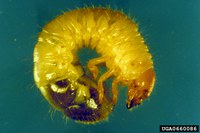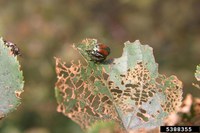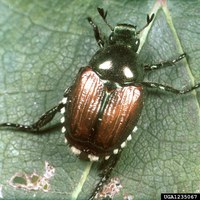Japanese Beetles Detected in N.D.
(Click an image below to view a high-resolution image that can be downloaded)
Japanese beetles, a highly destructive plant pest that feed on more than 300 host plants, have been detected in North Dakota again.
“Japanese beetles are established in most states east of the Mississippi River and in Kansas, Iowa, Minnesota, Montana, Nebraska, Oklahoma and South Dakota,” says Janet Knodel, North Dakota State University Extension Service entomologist.
Japanese beetle detection trapping has been conducted in North Dakota since 1960, and the pest was first detected in Burleigh County in 2001.
After the 2001 detection, Japanese beetles did not become established and were not detected in the annual Japanese beetle detection trapping surveys. However, a single Japanese beetle recently was detected in Grand Forks and several beetles were found in a pheromone trap operated by the North Dakota Department of Agriculture in West Fargo.
These beetles represent the second and third detections in North Dakota. Entomologists do not believed that the Japanese beetles have become established as a permanent resident in North Dakota.
“Japanese beetles are serious plant pests that attack more than 300 different host plants, including field crops (especially corn and beans), ornamentals, trees, shrubs, garden flowers, vegetables and turf grasses such as lawns, pastures and golf courses,” Knodel says.
Preferred host plants include roses, apples, birches, black cherries, cherries, flowering crab apples, plums, grapes, hollyhocks, blackberries, raspberries, lindens, elms and buckeyes.
“Adult beetles defoliate the leaves by feeding between the veins, which gives the plants a skeletonized appearance,” Knodel says. “Delicate leaves and petals of roses can be consumed completely. The beetle-damaged leaves act as an aggregation factor and draw in hundreds of beetles.”
Larvae (grubs) primarily feed on roots of grasses and can be a pest in pastures, lawns, golf courses and cemeteries. Root feeding reduces the ability of the plant to take up water and to tolerate other stresses such as drought.
“If you should see any pests you suspect are Japanese beetles or grubs, please collect them and notify Extension Entomology at (701) 231-7915 or your local Extension Service office,” Knodel says.
A NDSU fact sheet is being developed for best pest management recommendations for homeowners and professionals. When completed, it will be available at http://www.ndsu.edu/entomology/extension/.
NDSU Agriculture Communication – Aug. 16, 2012
| Source: | Janet Knodel, (701) 231-7915, janet.knodel@ndsu.edu |
|---|---|
| Editor: | Rich Mattern, (701) 231-6136, richard.mattern@ndsu.edu |




